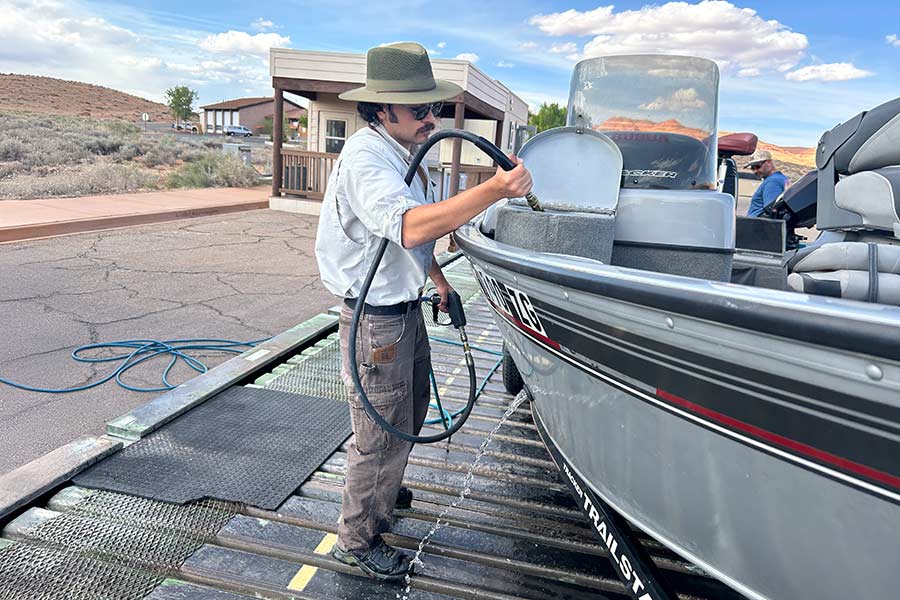Over 13K boats inspected for aquatic invasive species during Pioneer Day weekend
Salt Lake City — Utah Department of Natural Resources officers, Utah Division of Wildlife Resources technicians and personnel from other partner agencies were hard at work inspecting and decontaminating watercraft during the busy July 24th weekend. The main goal of this effort was to prevent quagga mussels and other aquatic invasive species — including Eurasian watermilfoil — from Lake Powell and from infested reservoirs outside the state from spreading to other waterbodies in Utah.
Statewide, aquatic invasive species technicians with the DWR, Utah State Parks, Arizona Game and Fish Department and the National Park Service, as well as DNR natural resources officers, inspected 13,383 boats and performed 260 decontaminations from Thursday to Monday. Of those total numbers, 1,189 of the boat inspections and 55 of the decontaminations took place at inspection stations in the Lake Powell area. This Pioneer holiday was slower than previous Pioneer holidays across the state and at Lake Powell.
Statewide, DNR officers detected 44 violations of Utah laws established to prevent the spread of invasive mussels. The majority of the violations this year were due to: Failure to Complete the Mussel Aware Course, Failure to Pay the Aquatic Invasive Species Fee, and Failure to Remove Drain Plugs During Transport. Bypassing our Mandatory Watercraft Inspection Stations for Aquatic Invasive Species remains a concern, especially at our Kanab location.
- Boaters failing to take the mandatory mussel-aware boater program course and not paying the associated aquatic invasive species fee for motorized boats
- Boaters failing to remove drain plugs while transporting their watercraft
"We want to remind boaters that we have a new aquatic invasive species mandatory inspection station in Kanab," Utah Department of Natural Resources Law Enforcement Aquatic Invasive Species Statewide Operations Lt. Bruce Johnson said. "If you're traveling with a boat or other watercraft in this area, you are required to stop at the inspection station. Even watercraft that have been inspected at Lake Powell are required to stop at operating mandatory inspection stations to verify their inspection. Having everyone do their part is what helps prevent the spread of aquatic invasive species in Utah."
There are over 40 inspection stations located at various waterbody boat ramps, along highways and at Port of Entry stations throughout Utah. There are also five dip tanks across the state that more efficiently and effectively decontaminate complex boats. The dip tanks are all free to use and are typically close to either the entrance of a state park or near a boat ramp. Dip tanks have been installed at the following locations around Utah:
- Lake Powell — Stateline Launch Ramp at Wahweap Marina (May 2021)
- Utah Lake State Park (May 2023)
- Sand Hollow State Park (October 2023)
- Lake Powell — Bullfrog Marina (May 2024)
- Willard Bay State Park (May 2024)
Negative impacts of quagga mussels
- They plug water lines, even lines that are large in diameter.
- If they get into water delivery systems, it will cost millions of dollars annually to remove them and keep the pipes free, which can result in higher utility bills.
- They remove plankton from the water, which hurts fish species.
- Mussels get into your boat's engine cooling system. Once they do, they'll foul the system and damage the engine.
- When mussels die in large numbers, they stink and the sharp shells of dead mussels also cut your feet as you walk along the beaches.
Negative impacts of Eurasian watermilfoil
- This invasive plant is negative for aquatic ecosystems because it spreads quickly and grows in thick mats. Its density blocks out sunlight, and it outcompetes native plants, negatively impacting fish and other native aquatic species.
- Transporting even one piece of Eurasian watermilfoil (also called milfoil) to another waterbody can start a new population of the plant in that waterbody.
- Milfoil can clog irrigation pipes.
- It also can tangle around boat propellers and cause damage.
- Removing milfoil from a waterbody once it's found there is extremely expensive.
Visit the STD of the Sea website for a list of all the decontamination stations around the state and for more information about requirements for boaters and others using nonmotorized watercraft.

















